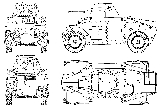
39M Csaba
Encyclopedia
The 39M Csaba was an armoured scout car produced for the Royal Hungarian Army during World War II
.
Hungarian expatriate Nicholas Straussler
designed several armoured cars for Britain while living there between the two world wars. Straussler came to an agreement with the Weiss Manfred factory of Csepel, Budapest
to produce vehicles from his designs for use in his home country - the most prominent was the Csaba (named after the son of Attila the Hun
) which was designed based on his experience of the Alvis
AC2 armoured car.
After successful trials in 1939, the Hungarian Army placed an order for 61, and a further order for an additional 40 vehicles was placed in 1940. Of these, twenty were used as actual fighting vehicles, with the remainder serving as armoured command cars and reconnaissance vehicles.
The Csaba had a 20mm cannon and an 8mm machine gun fixed on a centrally mounted turret, with 9mm armoured plating. The vehicle was also equipped with a detachable 8mm light machine gun fired through the rear hatch in the anti-aircraft role. The crew could dismount and carry this MG when conducting reconnaissance on foot. It also had two driving positions - one at the front as normal, and an additional one at the rear.
The 40M Csaba was a command version armed only with the turret mounted 8mm machine gun. This vehicle was fitted with a second R-4T radio which had a large lattice radio mast.
World War II
World War II, or the Second World War , was a global conflict lasting from 1939 to 1945, involving most of the world's nations—including all of the great powers—eventually forming two opposing military alliances: the Allies and the Axis...
.
Hungarian expatriate Nicholas Straussler
Nicholas Straussler
Nicholas Straussler was an engineer mainly remembered for devising the flotation system used by Allied amphibious DD tanks during World War II. Born in Hungary, he developed a reputation as an innovative automotive engineer before moving to Britain during the interwar period...
designed several armoured cars for Britain while living there between the two world wars. Straussler came to an agreement with the Weiss Manfred factory of Csepel, Budapest
Csepel
Csepel is the 21st district and a neighbourhood in Budapest, Hungary. Csepel officially became part of Budapest on 1 January 1950.- Location :...
to produce vehicles from his designs for use in his home country - the most prominent was the Csaba (named after the son of Attila the Hun
Attila the Hun
Attila , more frequently referred to as Attila the Hun, was the ruler of the Huns from 434 until his death in 453. He was leader of the Hunnic Empire, which stretched from the Ural River to the Rhine River and from the Danube River to the Baltic Sea. During his reign he was one of the most feared...
) which was designed based on his experience of the Alvis
Alvis Cars
Alvis Car and Engineering Company Ltd was a British manufacturing company that existed in Coventry, England from 19191967. In addition to automobiles designed for the civilian market, the company also produced racing cars, aircraft engines, armoured cars and other armoured fighting vehicles, the...
AC2 armoured car.
After successful trials in 1939, the Hungarian Army placed an order for 61, and a further order for an additional 40 vehicles was placed in 1940. Of these, twenty were used as actual fighting vehicles, with the remainder serving as armoured command cars and reconnaissance vehicles.
The Csaba had a 20mm cannon and an 8mm machine gun fixed on a centrally mounted turret, with 9mm armoured plating. The vehicle was also equipped with a detachable 8mm light machine gun fired through the rear hatch in the anti-aircraft role. The crew could dismount and carry this MG when conducting reconnaissance on foot. It also had two driving positions - one at the front as normal, and an additional one at the rear.
The 40M Csaba was a command version armed only with the turret mounted 8mm machine gun. This vehicle was fitted with a second R-4T radio which had a large lattice radio mast.

